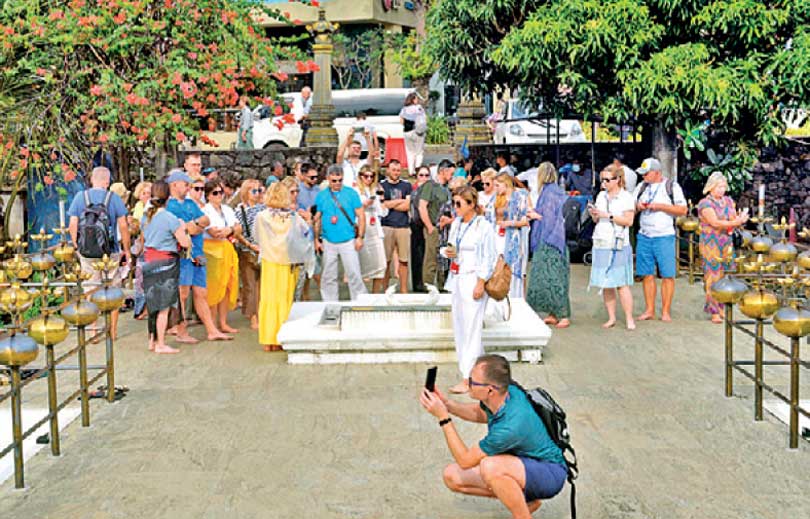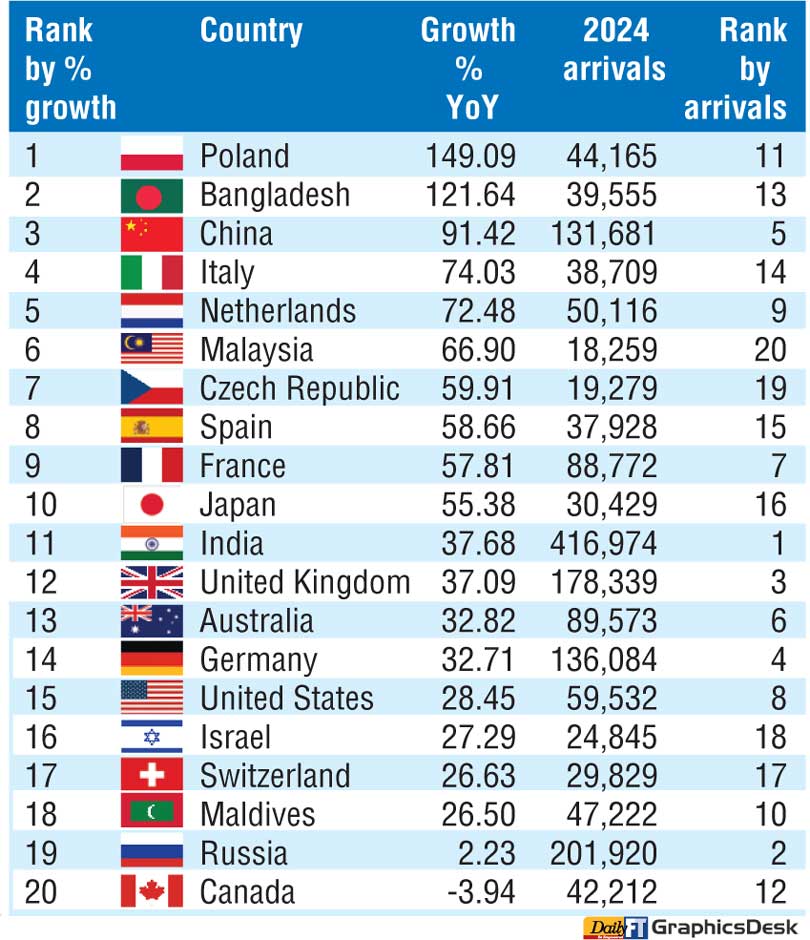Tuesday Apr 08, 2025
Tuesday Apr 08, 2025
Tuesday, 21 January 2025 02:56 - - {{hitsCtrl.values.hits}}


By Charumini de Silva
Sri Lanka’s tourism industry experienced a remarkable growth in 2024 with over 2.05 million visitors, as unconventional markets outpaced traditional powerhouses in growth.
Despite traditional markets like India and Russia retaining their dominance in terms of total arrivals, a deeper analysis of year-on-year (YoY) growth trends revealed intriguing shifts, with new markets showcasing noteworthy increases.
Poland emerged as the standout performer, recording a staggering 146.09% YoY increase in visitor numbers. Despite ranking 11th in terms of total arrivals, Poland’s performance highlights its untapped potential in the Eastern European market and growing significance within the country’s tourism mix. Similarly, Bangladesh posted an impressive 121.64% YoY growth, securing its position as the second fastest growing market, although ranked 13th in total arrivals last year.
China, long considered as a key generating market, registered a robust 91.42% YoY increase, placing it third in growth rankings and maintaining its stronghold as the fifth largest source of tourists to Sri Lanka.
Italy followed closely with a 74.03% YoY increase, reflecting a renewed European interest in the island nation, while Netherlands rounded out the top five with a 72.48% surge in growth during 2024.
Other markets also demonstrated substantial YoY growth. Malaysia saw a 66.90% YoY rise, while the Czech Republic registered a 59.91% YoY increase, highlighting the diversity of emerging tourist markets. Spain, France, and Japan followed suit, registering a 58.66%, 57.81%, and 55.38% YoY growth, respectively.
Traditional strongholds like India, the UK, and Germany posted more moderate growth rates.
Sri Lanka’s largest source market, India, which contributed with 416,974 arrivals, registered only a 37.68% YoY growth, whilst the UK and Germany, which ranked third and fourth in total arrivals, grew by 37.09% and 32.71% YoY, respectively.
Resurgence of non-traditional markets such as Australia, the US, Israel, Switzerland, andMaldives reflected evolving travel patterns, registering 32.82%, 28.45%, 27.29%, 26.63%, and 26.50% YoY growth, respectively. Switzerland was the only country that retained its arrivals and growth rank at 17th.
Interestingly, Russia – the second-largest source market in 2024 which drew 201,920 arrivals – experienced only a modest 2.23% YoY increase.
Canada, once a steady contributor, saw a decline of 3.94% YoY in visitor numbers, reflecting the only negative trend among the top 20 markets and otherwise promising 2024.
The diversification of the tourist base signals a promising future for the industry, as the Sri Lanka Tourism Promotion Bureau (SLTPB) is set to launch a unified national brand this month, replacing fragmented campaign taglines to enhance the country’s global tourism appeal and achieve a higher return on investment (RoI).
Last week, the Cabinet of Ministers approved an extension of tax concessions for airlines operating into three key airports — Jaffna International Airport, Colombo International Airport (Ratmalana), and Mattala Rajapaksa International Airport. The move augurs well to increase air traffic – attracting international carriers – utilise facilities, and boost tourism.
“These concessionary schemes are part of a broader strategy to enhance connectivity, attract more tourists, and support local economic growth through increased travel activity. These measures also aim to encourage airlines to bring down ticket prices to attract more tourists to Sri Lanka,” Cabinet Spokesman and Minister Dr. Nalinda Jayatissa said at the weekly post-Cabinet meeting media briefing held on 6 January (https://www.ft.lk/front-page/Cabinet-extends-tax-incentives-to-boost-air-traffic-at-key-airports/44-771527).
The rising significance of markets such as Poland, Bangladesh, China, Italy, and Netherlands suggests a shift away from over-reliance on traditional source markets. In addition, sustained growth in established markets like India, UK, France, Australia, Germany, and Japan offers stability as the country navigates its ambitious growth trajectory.
The analysis also points to the country’s evolving market landscape not only boosts arrivals, but also provides resilience against unforeseen challenges, ensuring a robust and dynamic tourism industry.
Sri Lanka aims to woo 3 million arrivals and $ 5 billion revenue this year. A long-term strategy is also in place to draw over 5 million visitors with an anticipated revenue range of $ 8.5 to $ 10 billion by 2030.
Discover Kapruka, the leading online shopping platform in Sri Lanka, where you can conveniently send Gifts and Flowers to your loved ones for any event including Valentine ’s Day. Explore a wide range of popular Shopping Categories on Kapruka, including Toys, Groceries, Electronics, Birthday Cakes, Fruits, Chocolates, Flower Bouquets, Clothing, Watches, Lingerie, Gift Sets and Jewellery. Also if you’re interested in selling with Kapruka, Partner Central by Kapruka is the best solution to start with. Moreover, through Kapruka Global Shop, you can also enjoy the convenience of purchasing products from renowned platforms like Amazon and eBay and have them delivered to Sri Lanka.
Discover Kapruka, the leading online shopping platform in Sri Lanka, where you can conveniently send Gifts and Flowers to your loved ones for any event including Valentine ’s Day. Explore a wide range of popular Shopping Categories on Kapruka, including Toys, Groceries, Electronics, Birthday Cakes, Fruits, Chocolates, Flower Bouquets, Clothing, Watches, Lingerie, Gift Sets and Jewellery. Also if you’re interested in selling with Kapruka, Partner Central by Kapruka is the best solution to start with. Moreover, through Kapruka Global Shop, you can also enjoy the convenience of purchasing products from renowned platforms like Amazon and eBay and have them delivered to Sri Lanka.